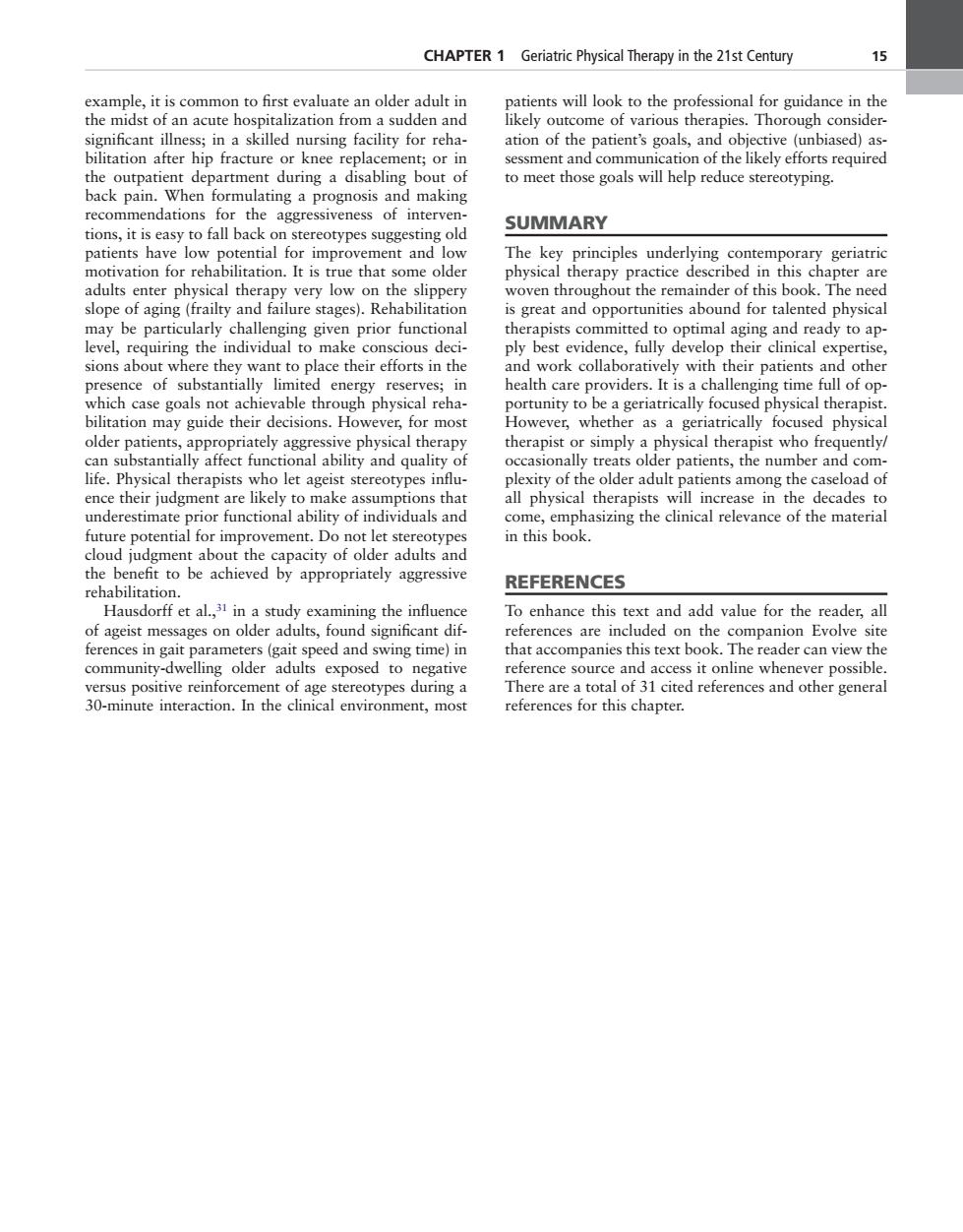正在加载图片...

CHAPTER 1 Geriatric Physical Therapy in the 21st Century 15 enificant ilness:in a skilled nursing facility for reha- ation of the patient's goals,and objective (unbiased)as bilitation after hip fracture or knee replacement;or in sessment and communication of the likely efforts required back udepartment during a disabline oking to meet those goals will help reduce stereotyping. making SUMMARY The key principles underlying contemporary geriatric rehabilitation.It is true that some older physica therapy practice describe d in this ppery be particularly challer given prior functional mitted to c and ready t leveheindividua tomkoec e they want to place their efforts in the stanti energy reserves their paticnts enging tim of op older patients,appropriately aggressive physical therapy therapists et ageist stereotypes inl among th underestimate rior functional ability of individuals and phasizin the clinical relevance of the material in this book REFERENCES Hausdorff et al in a study examining the influer To enhance this text and add value for the reader all of ageist messages on older adults.found s references are included on the comnanion Evolve site ferences in gait arameters (gait speed and swing time)in &ommnirydwelhngolderadwlhseposedoanegatg that accompanies this text book.The reader can view the reference source and ing a er gener. CHAPTER 1 Geriatric Physical Therapy in the 21st Century 15 example, it is common to first evaluate an older adult in the midst of an acute hospitalization from a sudden and significant illness; in a skilled nursing facility for rehabilitation after hip fracture or knee replacement; or in the outpatient department during a disabling bout of back pain. When formulating a prognosis and making recommendations for the aggressiveness of interventions, it is easy to fall back on stereotypes suggesting old patients have low potential for improvement and low motivation for rehabilitation. It is true that some older adults enter physical therapy very low on the slippery slope of aging (frailty and failure stages). Rehabilitation may be particularly challenging given prior functional level, requiring the individual to make conscious decisions about where they want to place their efforts in the presence of substantially limited energy reserves; in which case goals not achievable through physical rehabilitation may guide their decisions. However, for most older patients, appropriately aggressive physical therapy can substantially affect functional ability and quality of life. Physical therapists who let ageist stereotypes influence their judgment are likely to make assumptions that underestimate prior functional ability of individuals and future potential for improvement. Do not let stereotypes cloud judgment about the capacity of older adults and the benefit to be achieved by appropriately aggressive rehabilitation. Hausdorff et al.,31 in a study examining the influence of ageist messages on older adults, found significant differences in gait parameters (gait speed and swing time) in community-dwelling older adults exposed to negative versus positive reinforcement of age stereotypes during a 30-minute interaction. In the clinical environment, most patients will look to the professional for guidance in the likely outcome of various therapies. Thorough consideration of the patient’s goals, and objective (unbiased) assessment and communication of the likely efforts required to meet those goals will help reduce stereotyping. SUMMARY The key principles underlying contemporary geriatric physical therapy practice described in this chapter are woven throughout the remainder of this book. The need is great and opportunities abound for talented physical therapists committed to optimal aging and ready to apply best evidence, fully develop their clinical expertise, and work collaboratively with their patients and other health care providers. It is a challenging time full of opportunity to be a geriatrically focused physical therapist. However, whether as a geriatrically focused physical therapist or simply a physical therapist who frequently/ occasionally treats older patients, the number and complexity of the older adult patients among the caseload of all physical therapists will increase in the decades to come, emphasizing the clinical relevance of the material in this book. REFERENCES To enhance this text and add value for the reader, all references are included on the companion Evolve site that accompanies this text book. The reader can view the reference source and access it online whenever possible. There are a total of 31 cited references and other general references for this chapter